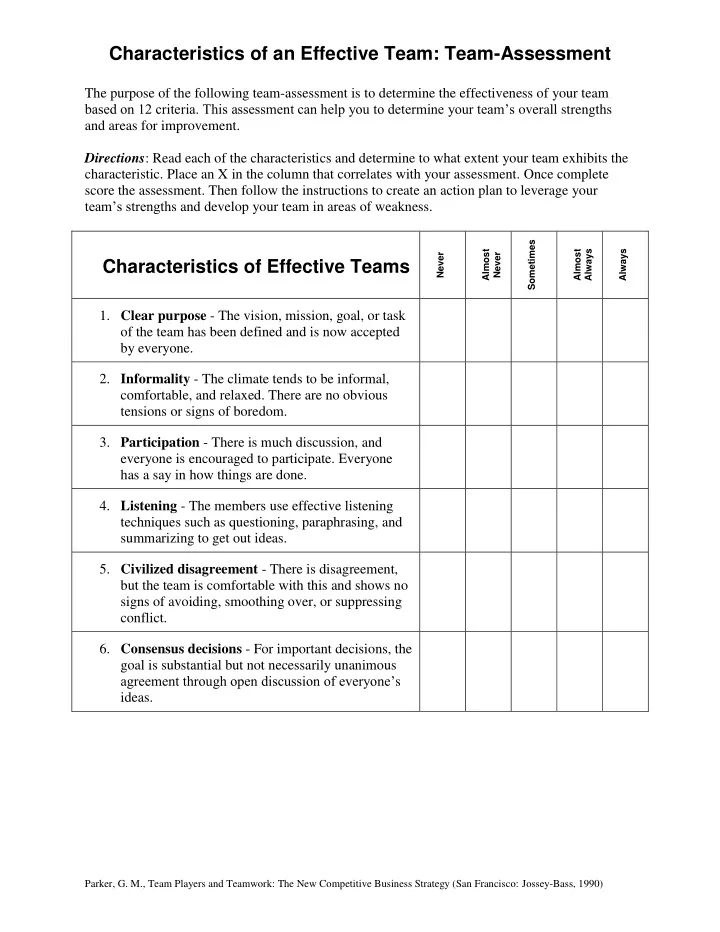

Characteristics of an Effective Team: Team-Assessment The purpose of the following team-assessment is to determine the effectiveness of your team based on 12 criteria. This assessment can help you to determine your team’s overall strengths and areas for improvement. Directions : Read each of the characteristics and determine to what extent your team exhibits the characteristic. Place an X in the column that correlates with your assessment. Once complete score the assessment. Then follow the instructions to create an action plan to leverage your team’s strength s and develop your team in areas of weakness. Sometimes Almost Almost Always Always Never Never Characteristics of Effective Teams 1. Clear purpose - The vision, mission, goal, or task of the team has been defined and is now accepted by everyone. 2. Informality - The climate tends to be informal, comfortable, and relaxed. There are no obvious tensions or signs of boredom. 3. Participation - There is much discussion, and everyone is encouraged to participate. Everyone has a say in how things are done. 4. Listening - The members use effective listening techniques such as questioning, paraphrasing, and summarizing to get out ideas. 5. Civilized disagreement - There is disagreement, but the team is comfortable with this and shows no signs of avoiding, smoothing over, or suppressing conflict. 6. Consensus decisions - For important decisions, the goal is substantial but not necessarily unanimous agreement through open discussion of everyone’ s ideas. Parker, G. M., Team Players and Teamwork: The New Competitive Business Strategy (San Francisco: Jossey-Bass, 1990)
Characteristics of an Effective Team: Team-Assessment 7. Open communication - Team members feel free to express their feelings on the tasks as well as on the group’s operation. There are few hidden agendas. Communication takes place outside of meetings. 8. Clear roles and work - There are clear expectations about the roles played by each team member. When action assignments are taken, clear assignments are made, accepted, and carried out. Work is fairly distributed among team members. 9. Shared leadership - While the team has a formal leader, leadership functions shift from time to time depending on the circumstances, the needs of the group, and the skills of the members. The formal leader models the appropriate behavior and helps establish positive norms. 10. External relations - The team spends time developing key relationships outside of the team, mobilizing resources, and building credibility with important players in other parts of the organization and community. 11. Style diversity - The team has a broad spectrum of team-player types including members who emphasize attention to task, goal setting, focus on process, and questions about how the team is functioning. 12. Self-assessment - Periodically, the team stops to examine how well it is functioning and what may be interfering with its effectiveness. Column Total (number of X’s in each column) Multiplier (used to multiply the column total) 1 2 3 4 5 Weighted Total (multiplier times the column total) Overall Assessment Total (sum of weighted totals) Parker, G. M., Team Players and Teamwork: The New Competitive Business Strategy (San Francisco: Jossey-Bass, 1990)
Characteristics of an Effective Team: Team-Assessment Overall Assessment Total Assessment totals range from a low of 12 points to a high of 60 points. 12 – 24 points Low performing team – multiple areas for improvement 25 – 48 points Middle performing team – shows strengths and areas for improvement 49 – 60 points High performing team – few areas for improvement Team Strengths – to be leveraged Read back through the assessment and determine the top 3 strengths. Gain consensus on these with your team. Write these in the top row of the table below. Next, determine 3 strategies for leveraging each strength and write these in the spaces provided below. Strengths 1. 2. 3. a. a. a. Strategies b. b. b. c. c. c. Team Weaknesses - areas for improvement Read back through the assessment and determine the top 3 weaknesses. Gain consensus on these with your team. Write these in the top row of the table below. Next, determine 3 strategies for developing the team in each area and write these in the spaces provided below. Weaknesses 1. 2. 3. a. a. a. Strategies b. b. b. c. c. c. Parker, G. M., Team Players and Teamwork: The New Competitive Business Strategy (San Francisco: Jossey-Bass, 1990)
Recommend
More recommend